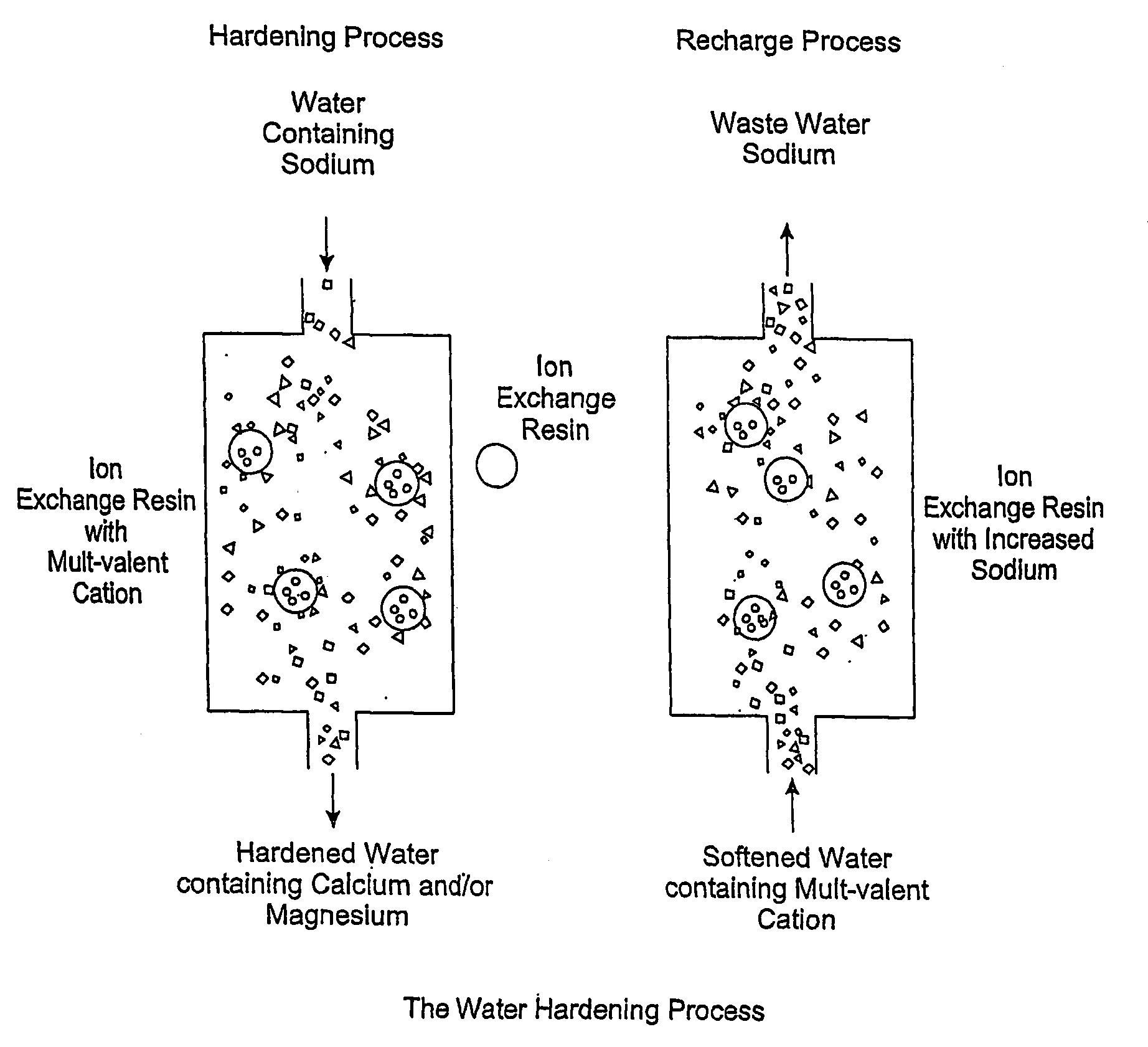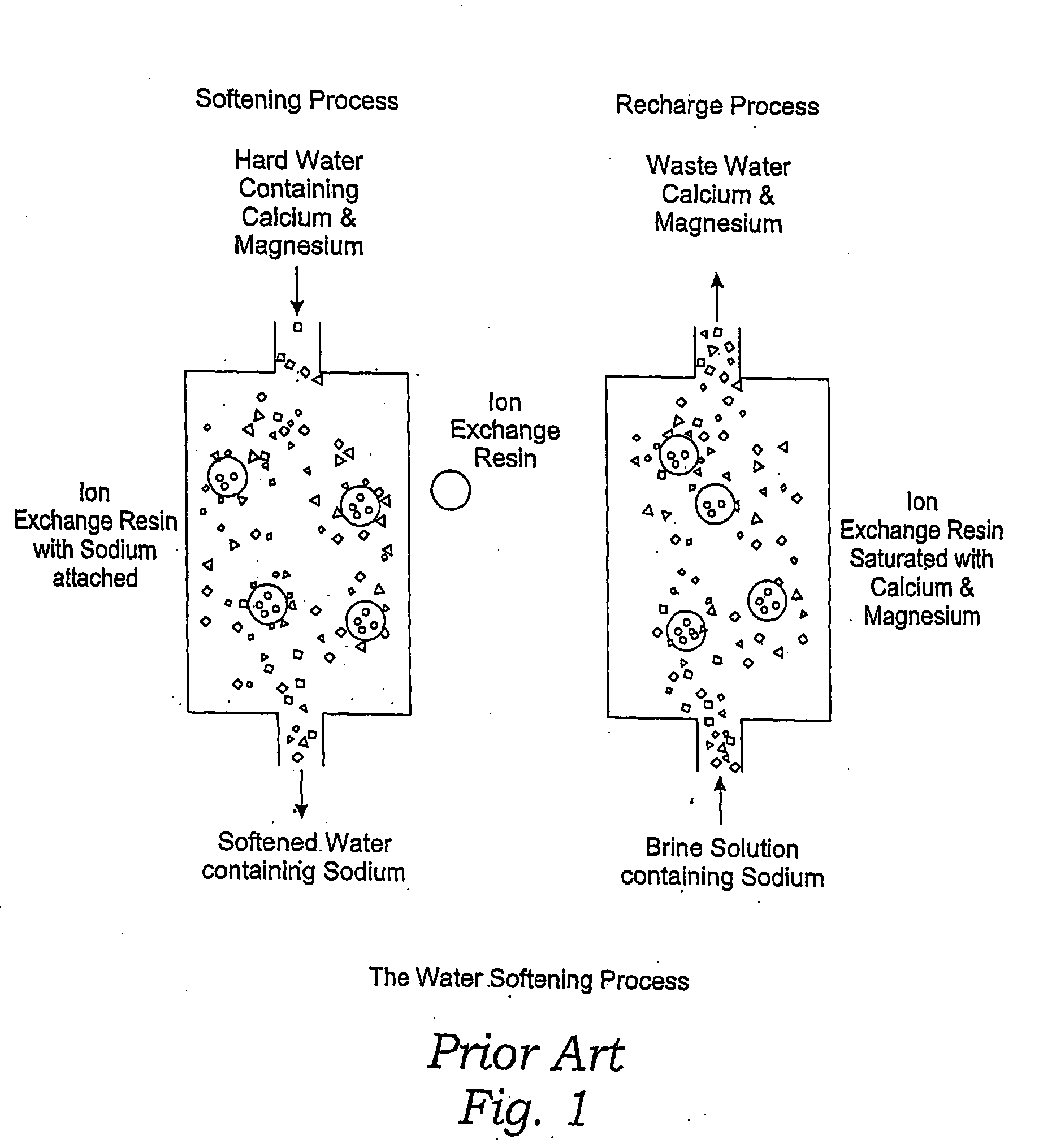Methods of Utilizing Waste Waters Produced by Water Purification Processing
a technology of water purification and waste water, applied in water/sewage treatment by ion exchange, separation processes, applications, etc., can solve the problems of high sodium content, unfavorable traditional mining, and high cost of california's state of california each year, and achieve the effect of reducing sodium conten
- Summary
- Abstract
- Description
- Claims
- Application Information
AI Technical Summary
Benefits of technology
Problems solved by technology
Method used
Image
Examples
example 1
[0052]Moderately saline well water is pumped from the Wonder Valley area, east of Twenty Nine Palms, Calif. Water from the well is measured at 1950 ppm TDS and water analysis reveals the following results.
Pre-Treatment - Moderately Saline WaterCationsResults (ppm)Calcium 51MagnesiumNot detectedSodium700
[0053]Using the chart of FIG. 3 reveals that the water has an SAR value of 29.
[0054]The well water is hardened by passing it through an ion exchange resin of Lewatit C-249 from Sybron Chemicals which has been saturated with calcium cation using a 13% solution of calcium chloride flushed at a rate of 15 lbs of calcium chloride per cubic foot of resin. After treatment, water analysis reveals the following results.
Post-Treatment - “Useful” WaterCationsResults (ppm)Calcium410Magnesium1.4Sodium380
[0055]Using the chart of FIG. 3 reveals that the water now has an SAR value of 5.0.
example 2
[0056]Moderately saline irrigation drainage water from Red Rock Ranch, Calif. is provided by the Department of Water Reclamation (“DWR”). The water is initially measured to have 5600 ppm TDS and water analysis reveals the following results.
Pre-Treatment - Moderately Saline WaterCationsResults (ppm)Calcium530Magnesium110Sodium1400
[0057]Because the chart of FIG. 3 cannot be used to reveal SAR value of the water, numerical calculations are performed to determine that the SAR is approximately 15.2.
[0058]As a result of its high initial calcium and magnesium levels, it is decided that the DWR water will undergo both a water softening process and a water hardening process. The water is treated through a water softening process to lower the calcium and magnesium levels to below 5 ppm as reflected in the following results.
Moderately Saline Water After Water SofteningCationsResults (ppm)CalciumNot detectedMagnesiumNot detectedSodium2200
[0059]The extremely high sodium level and low calcium and...
example 3
[0066]An ion exchange media is prepared by forming a column of chabasite within a 6 foot tube having a nominal interior diameter of 1.625 inch. The tube is filled with chabasite to produce a column 38 inches high after washing and regeneration. The chabasite, received in the sodium form, is saturated with calcium cation using a 15% solution of DowFlake brand calcium chloride at the rate of eight (8) pounds of calcium chloride per cubic foot of media. The column is then “broken in” by using it to remove sodium from brackish groundwater. Following the “breaking in” period, the ion exchange media is again regenerated using the 15% solution of DowFlake brand calcium chloride at the rate of eight (8) pounds of calcium chloride per cubic foot of media.
[0067]Solutions of sodium chloride are made using salt analyzed by EPA tests as being 6 ppm total Calcium plus Magnesium. The calculated amounts are checked with a Hach Sensioji 5 Meter as calibrated with a Hach Standard solution containing ...
PUM
| Property | Measurement | Unit |
|---|---|---|
| depth | aaaaa | aaaaa |
| interior diameter | aaaaa | aaaaa |
| interior diameter | aaaaa | aaaaa |
Abstract
Description
Claims
Application Information
 Login to View More
Login to View More - R&D
- Intellectual Property
- Life Sciences
- Materials
- Tech Scout
- Unparalleled Data Quality
- Higher Quality Content
- 60% Fewer Hallucinations
Browse by: Latest US Patents, China's latest patents, Technical Efficacy Thesaurus, Application Domain, Technology Topic, Popular Technical Reports.
© 2025 PatSnap. All rights reserved.Legal|Privacy policy|Modern Slavery Act Transparency Statement|Sitemap|About US| Contact US: help@patsnap.com



